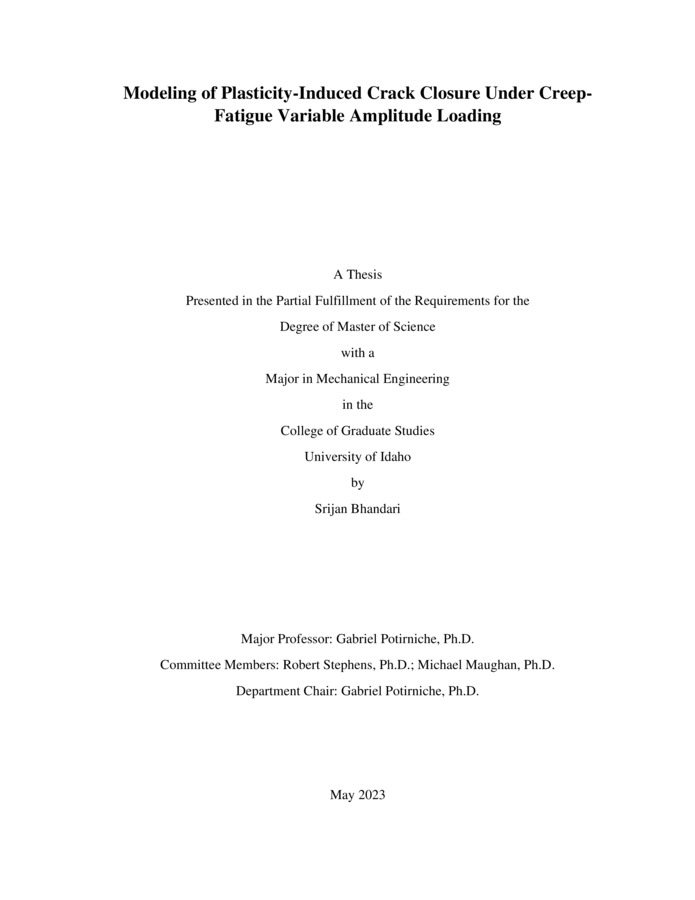Modeling of Plasticity-Induced Crack Closure Under Creep-Fatigue Variable Amplitude Loading
Bhandari, Srijan. (2023-05). Modeling of Plasticity-Induced Crack Closure Under Creep-Fatigue Variable Amplitude Loading. Theses and Dissertations Collection, University of Idaho Library Digital Collections. https://www.lib.uidaho.edu/digital/etd/items/bhandari_idaho_0089n_12599.html
- Title:
- Modeling of Plasticity-Induced Crack Closure Under Creep-Fatigue Variable Amplitude Loading
- Author:
- Bhandari, Srijan
- ORCID:
- 0009-0008-0859-7469
- Date:
- 2023-05
- Keywords:
- crack growth creep-fatigue opening load plasticity-induced crack closure variable amplitude loading
- Program:
- Mechanical Engineering
- Subject Category:
- Mechanical engineering
- Abstract:
-
Finite element simulations of fatigue crack growth (FCG) and creep-fatigue crack growth (CFCG) under constant amplitude (CA) and variable amplitude (VA) loading waveforms are performed to investigate the mechanics of crack opening and closing, which has implications on crack growth rate. The material of study is the ferritic-martensitic steel 9Cr-1Mo (modified 9Cr-1Mo) at 625 ⁰C. Two-dimensional finite element analyses of compact tension (CT) specimens are performed to simulate crack growth under several VA loading scenarios, considering elastic-plastic and creep deformation of the material at the crack tip. In this study, the relevant variable influencing crack growth rate is the crack opening load, caused by the phenomenon of plasticity-induced crack closure. A series of loading conditions were simulated using the finite element method, i.e., fatigue overload (OL) in either CA FCG or CFCG waveforms, creep-fatigue OL in CFCG waveforms, and underload (UL) in CFCG waveforms. The crack opening loads obtained from this study for CA loading in both FCG and CFCG, agree with data from published studies. This study found that a significant reduction in crack opening loads is experienced by the growing crack when an OL or UL cycle was introduced. Immediately after the OL or UL cycle is applied, the crack opening load increases during both fatigue OL and creep-fatigue OL to values larger than those recorded during CA FCG and CFCG loading, whereas UL waveforms resulted in consistently lower crack opening loads. The increase in crack opening loads is proportional to both the extent of OL and the duration of hold time in the OL cycle. However, following the application of a UL, the crack opening loads in the subsequent cycles were not influenced by the magnitude of the UL or the duration of hold time in the UL cycle.
- Description:
- masters, M.S., Mechanical Engineering -- University of Idaho - College of Graduate Studies, 2023-05
- Major Professor:
- Potirniche, Gabriel
- Committee:
- Stephens, Robert; Maughan, Michael
- Defense Date:
- 2023-05
- Identifier:
- Bhandari_idaho_0089N_12599
- Type:
- Text
- Format Original:
- Format:
- application/pdf
- Rights:
- In Copyright - Educational Use Permitted. For more information, please contact University of Idaho Library Special Collections and Archives Department at libspec@uidaho.edu.
- Standardized Rights:
- http://rightsstatements.org/vocab/InC-EDU/1.0/

